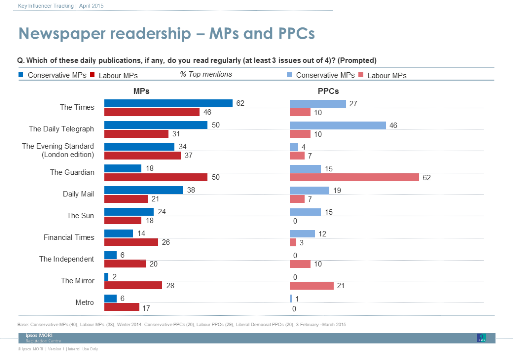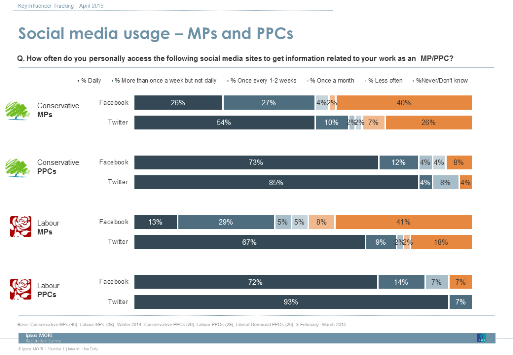Will this be the social media election?

“Prime minister, if I may say, I think you worry too much about what the papers say”
“Only a civil servant could have made that remark Bernard”
The relationship between the media and MPs, famously satirised in Yes Prime Minister, remains a key facet of political life within the UK. This represents a great opportunity for corporate communicators to shape opinions and never more so than in the months surrounding a general election. As the time that MPs have for direct forms of engagement disappear down the campaign trail, the media will assume increased importance as a communications tool.
As was the case in last year’s edition of this report, MPs are still avid readers of newspapers with 64% (68% last year) reading two or more daily newspapers on a regular basis (at least 3 out of 4 editions). The Times and Daily Telegraph remain the most regularly read daily newspapers among MPs as a group (54% and 38% respectively), followed in third by the Evening Standard (35%), which has strong cross party appeal. The findings also display the partisan nature of newspaper readership, with wide party splits across several of the most popular dailies.
Newspaper readership among PPCs however presents a slightly different picture, with notable variation between this group and their MP colleagues in both the frequency of newspaper consumption and the newspapers consumed. With the exception of Labour PPCs’ readership of the Guardian, PPCs from both of the main parties read the daily newspapers with less frequency than their MP colleagues - only 47% of PPCs read two or more daily newspapers frequently, vs. 64% of MPs. To some extent this finding may be reflective of the declining influence of non-digital forms of communication among younger generations, raising a question around the relative importance of newspapers as a source of influence within Westminster in the long-term.

Though the findings above suggest that newspapers currently play an important role in shaping MPs’ opinions, the battle for hearts and minds is increasingly being waged on digital platforms. For both MPs and PPCs, social media is playing an ever more important role as a source of engagement and nowhere is this more visible than through the recent raft of images showing politicians uncomfortably posing for selfies with willing victims on the campaign trail.
Findings show that while Tory MPs are slightly more likely to access Facebook on a regular basis, their Labour counterparts spend more time on Twitter. While the data for MPs suggests that social media is important, if not essential, to the current cohort of parliamentarians, the comparative data for PPCs is extremely illuminating.

Almost three quarters of Conservative (73%) and Labour (72%) PPCs access Facebook on a daily basis, vastly outstripping the comparative numbers for MPs (Conservative 26%, Labour 13%). Similarly for Twitter, both Conservative (85%) and Labour (93%) PPCs are much more likely to use this site on a daily basis than MPs from both the main parties (Conservative 54%, Labour 67%). Viewed alongside the numbers for PPC newspaper readership, these findings clearly indicate the increasing role that social media will need to play in future Westminster engagement strategies.
But what of blogs? Recently seen as one of the most influential forms of media communication, the relative importance of this channel is now being questioned. Though the findings for MPs and PPCs do not show a sharp drop off in blog patronage, particularly among Conservative MPs, the comparative numbers for Labour MPs and PPCs show a lower level of engagement.
Consistent with the situation in last year’s report on this topic, the Conservative blogosphere is considerably more developed than that of Labour, with the right leaning Guido Fawkes and Conservative Home, being the most popular blog sites overall – largely driven by the regular patronage of Conservative MPs and PPCs. Labour MPs and PPCs are most likely to regularly access Labour List; however, Labour MPs consumption of this blog and others has declined markedly since 2013, suggesting a softening in the level of influence that this media channel commands within the party.

Overall the news is good for corporate communicators. MPs remain avid consumers of mass media and the growing influence of social media increases the potential for building highly targeted communications campaigns that deliver tailored sources of information directly to the Twitter feed or Facebook page of influential parliamentarians. Understanding how to leverage the power of these platforms remains a challenge for communications executives; however, the ability to shape opinions using social media could undoubtedly play a key role in defining the success of many campaigns in the crucial upcoming months.
Ipsos’s Survey of Prospective Parliamentary Candidates runs in the months before the general election. We interview c.100 candidates for election in marginal seats, defined as those needing less than a 15% swing to displace an incumbent. Interviews are carried out face-to-face. Results in this article are from fieldwork conducted in February/March 2015Ipsos’s Survey of Prospective Parliamentary Candidates runs in the months before the general election. We interview c.100 candidates for election in marginal seats, defined as those needing less than a 15% swing to displace an incumbent. Interviews are carried out face-to-face. Results in this article are from fieldwork conducted in February/March 2015
Ipsos’s Survey of MPs runs biannually in the summer and winter. We interview c.100 MPs face-to-face each wave. Results are weighted to be representative of the house in terms of party and ministerial status. Results in this article are from fieldwork conducted in November/December 2014.
Ipsos’s Survey of Prospective Parliamentary Candidates runs in the months before the general election. We interview c.100 candidates for election in marginal seats, defined as those needing less than a 15% swing to displace an incumbent. Interviews are carried out face-to-face. Results in this article are from fieldwork conducted in February/March 2015



